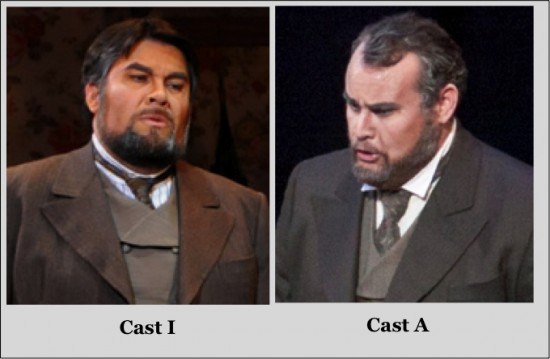Here’s the Opera Nut again with a few more thoughts after two weeks and two complete performances of La Traviata.

God (the Opera Nut) sees that Eve (Sara) has taken a bite from the forbidden fruit; photo by Jack Owicki
No, the picture above is NOT part of La Traviata. It’s just proof that we did have to leave early from the performance two weeks ago as mentioned in the first paragraph of Part I. Incidentally, you may want to read or reread that review before proceeding with this one.
As you may know, Opera San JosÉ double-casts most of the roles in its run of 8 performances. In an effort to discourage audiences in general (and reviewers in particular) from “ranking” the two casts, they label them Cast I and Cast A. To keep the record straight, Cast I with Rebecca Davis performed on the 12th and 26th, and Cast A, led by Jouvanca Jean-Baptiste, on the 19th.

The middle Sunday, February 19, I saw all 4 acts with Cast A. And they were good. They were very good. All of them were good. They all sang beautifully, and their voices complemented each other; I have no fault to find with any of the acting.
Sometimes, after seeing both casts of a performance I observe significant differences between them – not necessarily that one is “better” than the other, simply that they are different. Some years ago I saw both casts of a Tosca production in which one singer was noticeably older than the other. They gave quite different impressions of her as a diva and as a lover, but both were very convincing.

Cast I: Violetta (Rebecca Davis) & Alfredo (Michael Daily); Cast A: Violetta (Jouvanca Jean-Baptiste) & Alfredo (Alexander Boyer); photos by R. Shomler
Not so with Opera San JosÉ’s production of La Traviata. In fact the only obvious difference was skin deep. Both leading couples were racially mixed, but the mixture was reversed as is clear from their pictures. Interestingly, Cast I in particular was remarkably true to history, since Marie Duplessis was French with a pure white skin, and Alexandre Dumas, fils‘ mother was the West Indian mistress of Alexandre Dumas père, who freely acknowledged his paternity.

Cast I: Giorgio Germont (Evan Brummel); photo by R. Shomler; Cast A: Giorgio Germont (Torlef Borsting); photo by P. Kirk
There was, perhaps, a very slight difference in the interpretation of how the two baritones interpreted the character of Alfredo’s father, Giorgio Germont. There are few characters in all of opera that admit such different interpretations. In every case, in Act II he starts as the epitome of a despicable bigoted prig who regards Violetta as a much lower form of life – a scum that he wishes he didn’t have to recognize. Then, in the final Act as Violetta is dying, he apologizes for the sorrow he wrought. But there can be a world of difference in how he makes that apology. In the last couple of years, I have witnessed both of the extremes.

L: Lee Strawn in Pocket Opera production; photo courtesy Lee Strawn; R: Thomas Hampson in Royal Opera House production; photo by Catherine Ashmore
Two years ago I saw Lee Strawn in the Pocket Opera production directed by Nicolas Aliaga. As I wrote in my review:
In Act III Lee Strawn was not acting his remorse for his unfeeling rigidity in Act II; he was genuinely wishing he could undo that whole scene.
Then last year I saw the Royal Opera House production directed by Richard Eyre and wrote:
The third star, Thomas Hampson, completely restored my belief that Germont is one of the most villainous characters in all opera. He was such a completely cold, self-righteous, heartless, bigoted prig, that it was a real pleasure to hate him.
Anyhow, in this year’s Opera San JosÉ’s production, both Germonts were somewhere in between, with Torlef Borsting in Cast A being slightly closer to Hampson and Evan Brummel in Cast I being slightly more genuine in his apology.
Finally, on February 19 2012 I saw Rebecca Davis sing all the acts of La Traviata. If anything she was even better in Acts I and II – and the final act was no letdown. Believe me, I was not the only one to jump to my feet (well, at my age and state of decrepitude I didn’t exactly “jump”, but I wanted to) when the curtain popped back up to give the star a preview solo bow – and almost all of us were standing when she first appeared as part of the regular curtain call routine.
2149 Paragon Drive
San Jose CA 95131-1312
408-437-4450
345 South First Street
Betw San Carlos & San Salvador
Downtown San Jose
This review by Philip G Hodge appeared in sanfranciscosplash.com on March 6, 2012.

